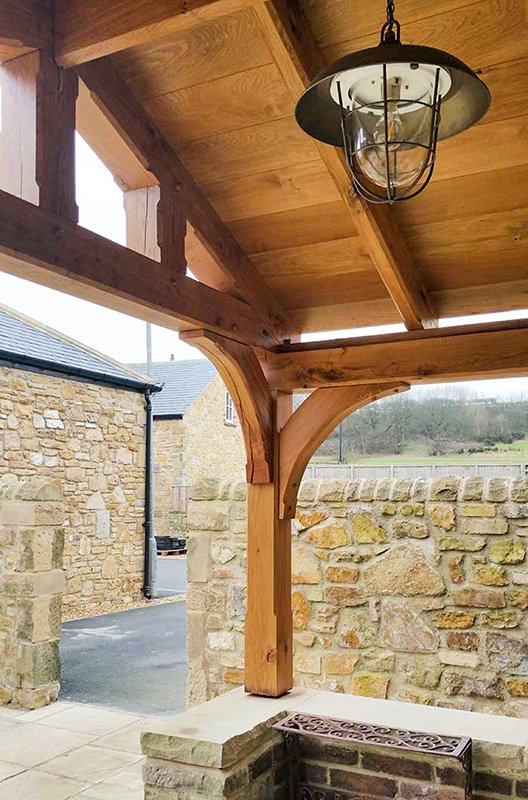
oakbydesign
01423 593 794



When deciding between green oak and air-dried oak, one must consider their distinct characteristics and applications. Green oak, fresh from the tree, boasts high moisture content, making it pliable and easy to work with for quick builds. On the other hand, air-dried oak, left to dry naturally, offers reduced moisture and increased stability, ideal for long-lasting projects like furniture. This fundamental difference influences not just the construction process but also the longevity and performance of the final product. So, what makes one type more suitable than the other for specific needs?
Green oak, freshly cut from the tree, retains a high moisture content, often exceeding 30%. This moisture makes it pliable and easier to machine, ideal for projects requiring immediate manipulation.
Its natural flexibility allows for simple cutting, shaping, and joining, reducing the need for specialised tools. However, its high moisture content also means green oak is prone to significant shrinkage and potential warping as it dries. This instability can affect structural integrity over time.
Despite these challenges, green oak’s cost-effectiveness and availability make it a preferred choice for temporary structures or projects where immediate use is essential. Builders must account for its drying behaviour to mitigate long-term issues.
While green oak offers immediate usability due to its high moisture content, air-dried oak stands out for its enhanced structural reliability and longevity.
Air-dried oak undergoes a natural drying process for at least 12 months, considerably reducing its moisture content. This results in increased dimensional stability, minimising the risks of warping, splitting, or shrinking over time.
Its improved hardness makes it more resistant to wear and tear, ideal for furniture, flooring, and structural applications. Additionally, air-dried oak’s tighter grain and richer colour contribute to its aesthetic appeal.
However, its greater density can make it more challenging to work with, requiring specialised tools and techniques. Despite these challenges, its long-term benefits make it a preferred choice for enduring projects.


For those seeking immediate workability in their woodworking projects, green oak offers a multitude of benefits. Its high moisture content makes it exceptionally pliable, facilitating easier cutting, shaping, and jointing using standard woodworking tools.
This immediate usability accelerates construction timelines, particularly for projects requiring rapid assembly. Additionally, the natural tannins in green oak provide a level of inherent resistance to insect infestation, enhancing its suitability for outdoor applications.
The fresh state of green oak also allows for tighter fittings, as it will shrink and tighten around joints as it dries. Cost-effective compared to its air-dried counterpart, green oak is an attractive option for budget-conscious projects, offering a balance of workability and initial structural integrity.
Air-dried oak often emerges as the superior choice for projects demanding longevity and robustness. This type of oak undergoes a natural drying process lasting at least 12 months, greatly reducing its moisture content.
The result is a material with enhanced structural integrity, making it less prone to warping and splitting over time. Its stability guarantees that the dimensions remain consistent, providing reliability for intricate joinery and fine woodworking.
Additionally, air-dried oak’s increased density and hardness contribute to its exceptional durability, making it ideal for high-traffic areas and outdoor applications.
Although it requires more effort to machine, the long-term benefits, including minimal maintenance and enduring aesthetic appeal, make air-dried oak a worthwhile investment.
Choosing the right oak demands a thorough understanding of the material’s properties and project requirements.
Green oak, with its high moisture content, is ideal for projects needing immediate workability and ease of machining. It’s particularly useful for short-term structures but may shrink and warp over time.
On the other hand, air-dried oak seasoned for at least 12 months, offers superior strength, stability, and durability, making it suitable for long-term applications. However, it’s harder to work with and more expensive.
Consider the project’s longevity, required strength, and budget when selecting oak. While green oak is cost-effective and manageable, air-dried oak provides enduring quality and structural integrity.
These factors are critical for making an informed choice.
PLEASE NOTE: OAK BY DESIGN ONLY USE AIR DRIED & KILN DRIED OAK IN THE MANUFACTURING OF OUR PRODUCTS.
Telephone: 01423 593 794
Locksley Park
Blind Lane
Tockwith
YORK YO26 7QJ
Opening Times:
Mon to Fri - 9.00am to 5.00pm
Bank Holidays - Closed
Christmas 2025- TBC
Oak By Design is the trading name of:
Oak By Design Ltd.
Reg Number: 04384416
VAT Number: 664 8012 33